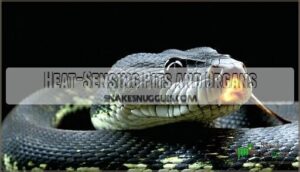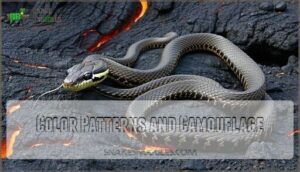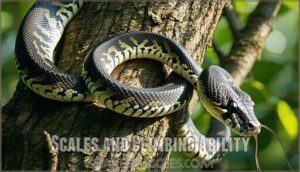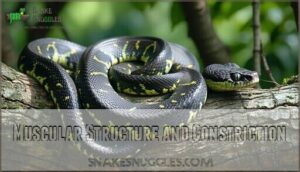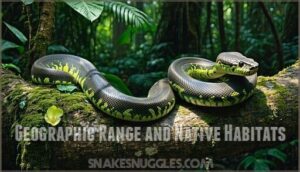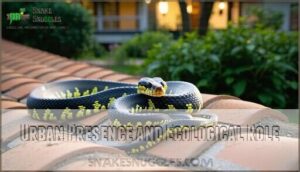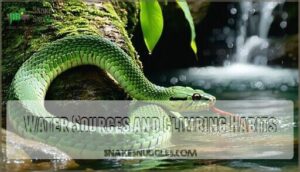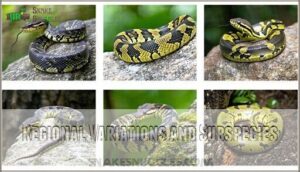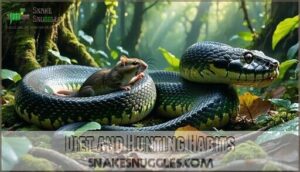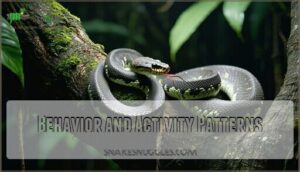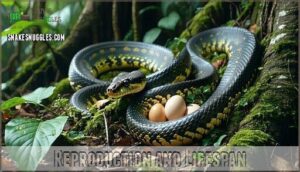This site is supported by our readers. We may earn a commission, at no cost to you, if you purchase through links.

Their remarkable serpents possess heat-sensing pits that detect warm-blooded prey in total darkness, acting like thermal goggles that give them a serious hunting advantage.
Their muscular bodies can stretch up to 13 feet long, while specialized belly scales help them climb trees with surprising agility.
You’d be amazed by their camouflage patterns that vary dramatically between regions – some look like living carpets while others resemble tree bark.
What’s really impressive is how they’ve adapted to thrive everywhere from rainforests to your backyard shed, making them a fascinating species.
Table Of Contents
- Key Takeaways
- Physical Characteristics
- Habitat and Distribution
- Diet and Hunting Habits
- Behavior and Activity Patterns
- Reproduction and Lifespan
- Frequently Asked Questions (FAQs)
- What are the unique features of carpet pythons?
- What’s the difference between a carpet snake and a python?
- What is the behavior of a carpet python?
- How do carpet pythons communicate with each other?
- What are carpet python mating rituals like?
- Can carpet pythons swim underwater effectively?
- Do carpet pythons hibernate or brumate annually?
- Are carpet pythons legal pets everywhere?
- Conclusion
Key Takeaways
- You’ll discover that carpet pythons possess heat-sensing pits along their lips that work like thermal goggles, allowing them to detect warm-blooded prey in complete darkness with incredible accuracy.
- You’ll find these snakes are exceptional climbers with muscular bodies up to 13 feet long and specialized belly scales that help them navigate trees and rocky terrain with surprising agility.
- You’ll notice their remarkable camouflage patterns vary dramatically between regions – some display diamond-shaped markings while others resemble tree bark, helping them blend seamlessly into their environments.
- You’ll be amazed by their adaptability to thrive everywhere from rainforests to suburban backyards, where they provide natural rodent control while maintaining their role as effective ambush predators.
Physical Characteristics
You’ll discover that carpet pythons possess remarkable physical features that set them apart from other snake species.
These Australian natives showcase a perfect blend of size, sensory capabilities, and adaptive traits that make them extraordinary predators.
Body Length and Shape
Measuring up to 13 feet in length, carpet pythons showcase remarkable size variations across their range.
You’ll notice sexual dimorphism clearly – males typically reach 5-6 feet while females grow 8-9 feet.
Their robust, muscular build supports incredible constriction strength.
These arboreal adaptations include a slender yet powerful body perfect for climbing.
Detailed scalation features sleek, shiny scales that aid movement through trees and rocky terrain.
Heat-Sensing Pits and Organs
When you’re hunting in the dark, carpet pythons don’t rely on eyesight alone.
These remarkable snakes possess heat-sensitive pits along their lips that detect infrared radiation from warm-blooded prey.
This evolutionary advantage gives them incredible pit accuracy for prey detection, basically providing infrared vision that works like thermal goggles.
Their heat-sensing organs represent millions of years of organ development perfecting thermoregulation abilities.
Color Patterns and Camouflage
You’ll notice remarkable pattern variations that serve as nature’s perfect disguise.
Carpet pythons showcase stunning color patterns ranging from diamond-shaped markings to irregular blotches in browns, yellows, and blacks.
These regional morphs provide exceptional camouflage effectiveness, helping them blend seamlessly into their environments.
The genetic basis for these variations creates distinct subspecies, with some displaying mimicry adaptations that enhance survival, which is a result of regional morphs.
Scales and Climbing Ability
You’ll notice carpet python scales possess a sleek, smooth texture that acts like nature’s climbing gear.
These glossy scales reduce friction, allowing seamless movement through branches during their arboreal lifestyle.
The unique scalation patterns aren’t just for show – they’re climbing adaptations that help these pythons grip bark and navigate tree canopies with remarkable ease.
Discoloration of the scales can indicate underlying health problems, which is a significant issue for their overall health.
Muscular Structure and Constriction
Beyond their smooth scales, carpet pythons pack serious muscle power.
Their constriction strength can squeeze prey with forces exceeding 200 pounds per square inch. This muscular endurance allows prolonged prey suffocation while specialized skeletal adaptations support their hunting strategy.
- Muscle fiber composition: Fast-twitch fibers deliver explosive constriction power during initial prey capture
- Reinforced ribcage: Skeletal adaptations prevent self-injury during powerful muscle contractions
- Pressure regulation: Muscle structure maintains consistent pressure throughout predator-prey dynamics without exhausting the snake
Habitat and Distribution
You’ll find carpet pythons across a massive range that spans mainland Australia, New Guinea, Papua New Guinea, and surrounding islands.
These adaptable serpents thrive in everything from lush rainforests and woodlands to rocky outcrops and even your suburban backyard, making them highly adaptable.
Geographic Range and Native Habitats
Since carpet pythons call Australia and New Guinea home, you’ll find these remarkable reptiles across diverse landscapes spanning two major landmasses.
Their Distribution extends from Australia’s eastern rainforests to New Guinea’s tropical zones, with Island Populations thriving on surrounding archipelagos.
These adaptable serpents inhabit woodlands, rocky outcrops, and coastal areas up to moderate Altitude Limits, showcasing impressive Habitat Diversity throughout their native range.
Adaptability to Various Environments
Throughout countless environments, you’ll find carpet pythons thriving where other species struggle.
Their remarkable adaptability stems from exceptional climatic tolerance and resource utilization skills.
These snakes colonize rainforests, woodlands, grasslands, and rocky outcrops with equal success.
Urban adaptation occurs naturally as they exploit new habitat diversity, and regional ecosystems benefit from their environmental needs flexibility, making them resilient against climate change impacts.
Urban Presence and Ecological Role
You’ll find carpet pythons thriving in Australian suburbs, making homes in roof spaces and gardens.
These urban adaptations showcase their remarkable flexibility in surviving city life. They provide excellent rodent control, naturally managing pest populations without chemicals.
Their suburban encounters with humans remain generally peaceful, though they occasionally cause concern. This ecosystem impact demonstrates how wildlife adapts to human environments while maintaining ecological balance.
ReptiChip offers ideal bedding options for these snakes, supporting their survival in urban settings with natural and effective solutions.
Water Sources and Climbing Habits
You’ll find carpet pythons are excellent climbers with strong muscular bodies perfectly suited for arboreal hunting.
Their climbing adaptations help them reach water sources in rainforests and woodlands.
These snakes show remarkable water dependency, often settling near streams and wetlands.
A proper water bowl is essential for their hydration.
Their habitat proximity to water supports both hydration strategies and hunting success, as prey animals frequently visit these areas for drinking.
Regional Variations and Subspecies
You’ll discover six distinct carpet python subspecies across Australia and nearby regions, each showcasing unique carpet python characteristics.
The diamond python displays stunning diamond markings, while coastal variations feature olive hues.
Jungle morphs boast vibrant yellow-black banding, and from Yule Island populations to montane adaptations, Morelia spilota subspecies demonstrate remarkable geographic ranges and color variations shaped by their environments, including remarkable geographic ranges.
Diet and Hunting Habits
You’ll discover that carpet pythons are master ambush predators who use powerful constriction to subdue their prey before swallowing it whole.
These skilled hunters can tackle everything from tiny lizards to large possums, making them incredibly effective at controlling rodent populations in both wild and suburban areas.
Ambush Predation and Constriction
You’ll witness nature’s most efficient killing machine in action when carpet pythons hunt.
These ambush predators use stealth tactics and strike precision to capture unsuspecting prey.
Their muscular strength delivers suffocation mechanics that quickly subdue victims through constriction, making their feeding habits remarkably effective.
- Lightning-fast strikes catch prey before they can react or escape
- Powerful coils wrap around victims, tightening with each exhale
- Heat-sensing pits detect warm-blooded animals in complete darkness
- Patient waiting can last hours until the perfect moment arrives
- Zero venom needed – pure muscle power does all the work
Prey Preferences and Feeding Frequency
You’ll discover carpet pythons aren’t picky eaters, but they’re smart about their choices.
Their python diet includes mammals, birds, and reptiles, with prey size matching their body dimensions.
Juvenile diet focuses on smaller animals like lizards, while adults tackle possums.
Their digestion rate allows feeding every few weeks, with seasonal feeding patterns adjusting to prey availability and temperature changes, which is a smart adaptation.
Hunting Strategies and Stealth
You’ll witness carpet pythons mastering ambush tactics through incredible stealth camouflage that lets them blend seamlessly into their surroundings.
Their constriction power delivers swift, efficient kills while heat-sensing pits enable precise prey detection.
These hunting adaptations make them formidable predators, combining patience with lightning-fast strikes that catch prey completely off-guard through stealthy hunting techniques.
Role in Controlling Rodent Populations
You’ll find carpet pythons working like nature’s pest control team in your neighborhood.
They consume massive numbers of rats and mice, providing ecosystem benefits through natural population control.
Their nighttime hunting perfectly targets peak rodent activity, preventing disease transmission and property damage.
This urban rodent control creates better ecosystem balance while reducing your need for chemical treatments.
They’re quite adaptable and can thrive in various habitat types, creating a more balanced ecosystem through their presence.
Adaptability to Different Prey Types
You’ll discover carpet pythons are nature’s ultimate opportunists in terms of feeding behavior.
These adaptable hunters adjust their snake diet based on prey availability and habitat influence.
5 Key Adaptations:
- Size constraints – Young pythons target lizards while adults tackle possums
- Seasonal changes – Switch between ground prey in winter, tree-dwelling birds in summer
- Dietary shifts – Move from reptiles to mammals as they grow larger
- Habitat influence – Forest pythons eat more birds; grassland ones prefer rodents
- Feeding habits flexibility prevents dietary deficiencies during prey shortages
Behavior and Activity Patterns
You’ll discover that carpet pythons lead fascinating lives shaped by their nocturnal instincts and remarkable adaptability.
These snakes showcase unique behavioral patterns that make them perfectly suited for survival in diverse Australian environments, driven by their nocturnal instincts.
Nocturnal Behavior and Peak Activity
When darkness falls, you’ll witness carpet pythons come alive with remarkable energy. Their nocturnal nature drives peak nighttime hunting activity, with heat-sensing pits detecting warm prey in complete darkness.
These snakes show fascinating seasonal activity patterns, becoming more active during warmer months.
Urban encounters increase at night when they hunt rodents near homes, though they’ll occasionally emerge for basking behavior during sunny days.
Social Behavior and Solitary Nature
Most carpet pythons embrace the lone wolf lifestyle, preferring Solitary Hunting over group activities.
You’ll rarely see these snakes together except during breeding season when Breeding Aggregation occurs.
Their python temperament remains independent year-round, making Human Interaction predictable since they don’t form social bonds.
In Captive Behavior studies, researchers note minimal communication between individuals, reinforcing their naturally solitary nature.
Defensive Mechanisms and Threat Response
When you encounter a threatened carpet python, you’ll witness its impressive defensive mechanisms in action.
The snake performs dramatic hissing and posturing displays, coiling its muscular body while releasing a musky odor.
Though painful bites can occur, these non-venomous serpents rarely attack unless cornered.
Their defensive posture includes threat display behaviors that effectively deter most predators, explaining suburban tolerance levels.
Climbing Ability and Tree-Dwelling
You’ll discover these serpents are nature’s ultimate acrobats. Their muscular bodies and smooth scales create perfect arboreal adaptations for traversing trees with ease.
Captive climbing requires tall enclosures with sturdy branches to support their impressive climbing ability. Providing a suitable arboreal snake enclosure is essential for their well-being.
These predation tactics allow them to hunt from elevated positions, using habitat elevation as both hunting ground and shelter.
Seasonal Variations and Environmental Factors
During spring and summer months, you’ll notice carpet pythons become more active as rising temperatures boost their body temperature regulation and metabolism.
Temperature influence drives their behavior since they rely on external heat sources for energy.
When rainfall impact increases prey abundance, these snakes emerge from winter brumation behavior, and climate impact affects habitat availability, causing occasional habitat shifting as they follow food sources through changing seasons.
Understanding their behavior also means recognizing that tail vibrations signal stress, which is a key indicator of their stress levels and overall well-being.
Reproduction and Lifespan
You’ll discover that carpet pythons have fascinating reproductive cycles that can produce impressive clutches of up to 50 eggs in a single breeding season.
These remarkable snakes can live surprisingly long lives, reaching 15-20 years in the wild and up to 30 years in captivity with proper care.
Breeding Season and Clutch Size
When autumn arrives, you’ll witness nature’s remarkable breeding triggers kick into action.
Sexual maturity reaches carpet pythons around three years old, launching their annual breeding season from May through July.
These incredible mothers can produce clutches containing up to fifty eggs! Breeding frequency typically occurs yearly, though some females may skip seasons after particularly large clutches to recover their energy reserves.
Incubation Period and Hatching Success
Temperature effects and humidity importance play vital roles during incubation.
You’ll find that proper clutch management guarantees ideal conditions for developing eggs.
The incubation period lasts approximately two months, with hatchling survival rates depending heavily on consistent environmental factors.
Without parental care, artificial incubation requires precise monitoring.
Successful breeding produces healthy hatchlings with good size variations, resulting in healthy hatchlings.
Growth Rate and Maturity Age
After their incubation period, carpet python hatchlings grow remarkably fast during their first few years.
Growth factors like temperature and food availability substantially influence how quickly they reach sexual maturity around three years old.
Captive growth often exceeds wild rates due to consistent feeding schedules.
You’ll notice size dimorphism becomes apparent as females mature larger than males, affecting their overall lifespan potential and breeding success in natural habitats.
Average Lifespan and Health Issues
Your carpet python’s lifespan depends heavily on care quality.
Captive lifespan reaches 20-30 years with proper husbandry, while wild threats reduce python lifespan to 15-20 years. Notably, some rattlesnake species, like the timber rattlesnake, can also live up to 20 years in the wild.
Common health issues include respiratory infections, parasites, and shedding problems. Preventative care through proper humidity, ventilation, and cleanliness substantially impacts longevity factors.
Regular vet checkups help maintain ideal health throughout their impressive carpet python size and lengthy lives.
Conservation Status and Threats
You’ll find carpet pythons listed as Least Concern on the IUCN Red List globally, but don’t let that fool you.
Habitat loss from agriculture and urban development threatens regional populations, while invasive species and the pet trade create additional conservation challenges.
Some subspecies face serious habitat threats, with Victoria’s Inland Carpet Python particularly vulnerable due to ongoing human persecution and climate change impacts.
Frequently Asked Questions (FAQs)
What are the unique features of carpet pythons?
You might be surprised to know these snakes can reach up to 13 feet long.
You’ll spot their diamond-shaped heads, glossy scales, and heat-sensing pits.
Their wild color patterns help them blend in, like nature’s own camouflage artists.
What’s the difference between a carpet snake and a python?
There’s actually no difference—"carpet snake" and "carpet python" refer to the same Australian reptile species.
You’ll hear both names used interchangeably, though "carpet python" is the more scientifically accurate term since they’re true pythons.
What is the behavior of a carpet python?
Like a patient predator waiting in shadows, you’ll find carpet pythons are primarily nocturnal hunters.
They’re skilled climbers who spend days basking and nights hunting, remaining solitary except during breeding season.
How do carpet pythons communicate with each other?
Carpet pythons communicate through chemical signals called pheromones that you’ll detect through their tongue-flicking behavior.
They release scent trails to attract mates during breeding season and use body language like defensive posturing when threatened.
What are carpet python mating rituals like?
During mating season, you’ll witness male carpet pythons engaging in combat dances, intertwining their bodies while competing for females.
They’ll also perform courtship rituals involving gentle touching and chemical communication through scent.
Can carpet pythons swim underwater effectively?
Yes, you’ll find carpet pythons can swim underwater effectively. They’re agile swimmers who use this skill for hunting, escaping predators, and moving between territories across rivers and waterways.
Do carpet pythons hibernate or brumate annually?
Most carpet pythons don’t hibernate but enter brumation during cold winters. You’ll notice they become less active in autumn and may brumate when temperatures drop substantially in their region.
Are carpet pythons legal pets everywhere?
Like traversing a legal minefield, reptile ownership laws vary dramatically worldwide.
You’ll need specific licenses in Australia, face varying state regulations in America, and encounter outright bans elsewhere, making universal legal ownership far from universal.
Conclusion
Through millions of years, carpet python unique characteristics have evolved like a master key revealing survival secrets.
You’ve discovered how their heat-sensing pits, incredible climbing abilities, and adaptive camouflage make them extraordinary hunters.
These remarkable serpents continue thriving across Australia’s diverse landscapes, from dense rainforests to suburban backyards.
Understanding carpet python unique characteristics helps you appreciate why they’re truly one of nature’s most fascinating predators.
- https://nre.tas.gov.au/Documents/Carpet-Python_Risk-Assessment-pdf.pdf
- https://www.holohil.com/wp-content/uploads/2017/05/Pearson-et-al-2005.pdf
- https://reptichip.com/blogs/animals/coastal-carpet-python
- https://espace.library.uq.edu.au/view/UQ:d6a94a6/s4405690_phd_thesis.pdf?dsi_version=82292ccab431c17bf6ba84c768a01f12
- https://pmc.ncbi.nlm.nih.gov/articles/PMC6007707/


